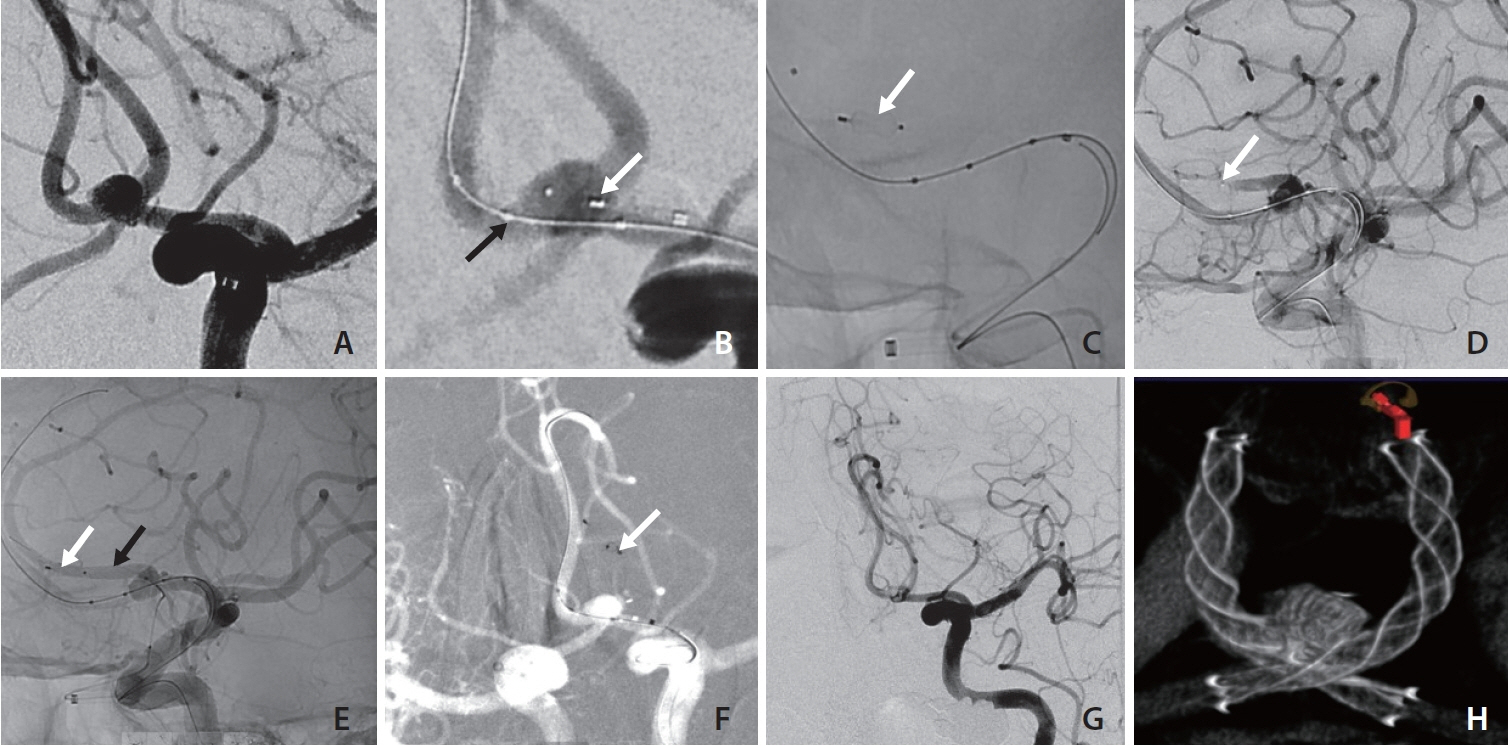Neurointervention.
2023 Jul;18(2):129-134. 10.5469/neuroint.2023.00136.
Woven EndoBridge Device Migration and Microsnare Retrieval Strategy: Single Institutional Case Reports with Technical Video Demonstration
- Affiliations
-
- 1Department of Neurosurgery, North Shore University Hospital, Donald and Barbara Zucker School of Medicine at Hofstra/Northwell, Manhasset, NY, USA
- KMID: 2543368
- DOI: http://doi.org/10.5469/neuroint.2023.00136
Abstract
- The Woven EndoBridge (WEB) (MicroVention/Terumo) device is a treatment option for wideneck bifurcation aneurysms. An uncommon adverse effect is WEB device migration. While certain bailout strategies for WEB recovery have been described, there is still a paucity of information on optimal strategies to maximize both short and long-term post-operative outcomes. We add 2 cases at our institution to the existing literature of WEBectomy in the setting of complicated intracranial aneurysm treatment. We discuss the long-term imaging outcomes with additional fluoroscopy video demonstrating our technique. Our findings reflect a clear benefit for the use of the Amplatz GooseneckTM microsnare (Medtronic) device as a means of WEB recovery, coupled with potential stent-assisted WEB embolization to remove the aneurysm from the parent circulation, while minimizing recurrence and thromboembolic complications.
Keyword
Figure
Reference
-
1. Heiferman DM, Peterson JC, Johnson KD, Nguyen VN, Dornbos D, Moore KA, et al. Woven EndoBridge embolized aneurysm clippings: 2-dimensional operative video. Oper Neurosurg (Hagerstown). 2021; 21:E365.
Article2. Pierot L, Moret J, Barreau X, Szikora I, Herbreteau D, Turjman F, et al. Aneurysm treatment with Woven EndoBridge in the cumulative population of 3 prospective, multicenter series: 2-year follow-up. Neurosurgery. 2020; 87:357–367.
Article3. Rai AT, Turner RC, Brotman RG, Boo S. Comparison of operating room variables, radiation exposure and implant costs for WEB versus stent assisted coiling for treatment of wide neck bifurcation aneurysms. Interv Neuroradiol. 2021; 27:465–472.
Article4. Dmytriw AA, Dibas M, Ghozy S, Adeeb N, Diestro JDB, Phan K, et al. The Woven EndoBridge (WEB) device for the treatment of intracranial aneurysms: ten years of lessons learned and adjustments in practice from the WorldWideWEB consortium. [published online ahead of print Sep 6, 2022]. Transl Stroke Res. 2022.
Article5. Goertz L, Liebig T, Siebert E, Pflaeging M, Forbrig R, Pennig L, et al. Stent-assisted WEB embolization: aneurysm characteristics, outcome and case report of a WEB delivered through a stent. Acta Neurochir (Wien). 2022; 164:2181–2190.
Article6. Goyal N, Hoit D, DiNitto J, Elijovich L, Fiorella D, Pierot L, et al. How to WEB: a practical review of methodology for the use of the Woven EndoBridge. J Neurointerv Surg. 2020; 12:512–520.
Article7. Cagnazzo F, Ahmed R, Zannoni R, Dargazanli C, Lefevre PH, Gascou G, et al. Predicting factors of angiographic aneurysm occlusion after treatment with the Woven EndoBridge device: a single-center experience with midterm follow-up. AJNR Am J Neuroradiol. 2019; 40:1773–1778.
Article8. Fortunel A, Javed K, Holland R, Ahmad S, Haranhalli N, Altschul D. Impact of aneurysm diameter, angulation, and device sizing on complete occlusion rates using the Woven Endobridge (WEB) device: single center United States experience. [published online ahead of print Mar 7, 2022]. Interv Neuroradiol. 2022.
Article9. Shah KA, White TG, Teron I, Link T, Dehdashti AR, Katz JM, et al. Volume-based sizing of the Woven EndoBridge (WEB) device: a preliminary assessment of a novel method for device size selection. Interv Neuroradiol. 2021; 27:473–480.
Article10. Gravino G, Masri S, Chandran A, Puthuran M. Management of WEB device migration and mal-position in endovascular treatment of cerebral aneurysms. [published online ahead of print Aug 25, 2022]. Interv Neuroradiol. 2022.11. Nazarian GK, Myers TV, Bjarnason H, Stackhouse DJ, Dietz CA Jr, Hunter DW. Applications of the Amplatz snare device during interventional radiologic procedures. AJR Am J Roentgenol. 1995; 165:673–678.
Article12. Salem MM, Ali A, Riina HA, Burkhardt JK. Bailout strategies for abrupt change in Woven Endobridge 17 device orientation after detachments: technical note of 2 anterior communicating artery aneurysm cases. World Neurosurg. 2022; 162:68–72.
Article13. Radu RA, Gascou G, Derraz I, Cagnazzo F, Costalat V. Micro-snare retrieval as bail-out technique for a distally migrated WEB-device: a case report. [published online ahead of print Aug 4, 2022]. Interv Neuroradiol. 2022.
Article14. Amuluru K, Al-Mufti F, Sahlein DH, Scott J, Denardo A. Adjustment of malpositioned Woven EndoBridge device using gooseneck snare: complication management technique. Neurointervention. 2021; 16:275–279.
Article15. Simgen A, Kettner M, Dietrich P, Tomori T, Mühl-Benninghaus R, Bhogal P, et al. Different rescue approaches of migrated Woven Endobridge (WEB) devices: an animal study. Clin Neuroradiol. 2021; 31:431–438.
Article16. Bañez RMF, Chong W. Retrieval of displaced Woven EndoBridge intrasaccular flow disruptor using solitaire platinum revascularization device. Neurointervention. 2022; 17:106–109.
Article17. Machi P, Jourdan F, Ambard D, Reynaud C, Lobotesis K, Sanchez M, et al. Experimental evaluation of stent retrievers’ mechanical properties and effectiveness. J Neurointerv Surg. 2017; 9:257–263.
Article18. Caroff J, Mihalea C, Tuilier T, Barreau X, Cognard C, Desal H, et al. Occlusion assessment of intracranial aneurysms treated with the WEB device. Neuroradiology. 2016; 58:887–891.
Article
- Full Text Links
- Actions
-
Cited
- CITED
-
- Close
- Share
- Similar articles
-
- Adjustment of Malpositioned Woven EndoBridge Device Using Gooseneck Snare: Complication Management Technique
- Woven Endobridge (WEB) augmented by Y-stent in a shallow basilar tip aneurysm
- Retrieval of Displaced Woven EndoBridge Intrasaccular Flow Disruptor Using Solitaire Platinum Revascularization Device
- Ten Years of Clinical Evaluation of the Woven EndoBridge: A Safe and Effective Treatment for Wide-Neck Bifurcation Aneurysms
- Vertebro-Vertebral Fistula Occlusion Using a Woven EndoBridgeTM-Device



